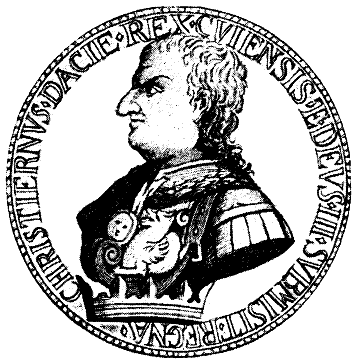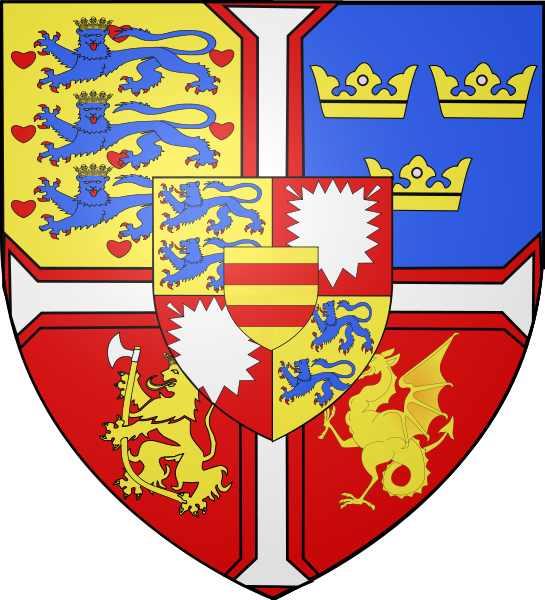<Back to Index>
- King of Denmark, Norway and Sweden Christian I, 1426
PAGE SPONSOR


Christian I (February 1426 – 21 May 1481) was a Danish monarch, king of Denmark (1448 – 1481), Norway (1450 – 1481) and Sweden (1457 – 1464), under the Kalmar Union. In Sweden his short tenure as monarch was preceded by regents, Jöns Bengtsson Oxenstierna and Erik Axelsson Tott and succeeded by regent Kettil Karlsson Vasa. Also Duke of Schleswig and Holstein 1460 – 81.
He was born in February 1426 in Oldenburg. His father was Count Dietrich of Oldenburg (died 1440) whom he succeeded as Count of Oldenburg and Delmenhorst. His mother was his father's second wife, Hedwig of Schleswig and Holstein (Helvig of Schauenburg) (died 1436). Christian had two brothers, Count Moritz V of Delmenhorst (1428 – 1464) and Count Gerhard VI of Oldenburg and Delmenhorst (1430 – 1500), and one sister Adelheid.
Christian married Dorothea of Brandenburg (1430 – 25 November 1495), the widow of his predecessor King Christopher (of Bavaria) and thus dowager queen, on 28 October 1449 in Copenhagen.
King Christopher of Denmark, Sweden and Norway died
in January 1448. His death resulted in the break up of the union of the
three kingdoms, as Denmark and Sweden went their separate ways. On 1
September 1448, count Christian of Oldenburg was elected to the vacant
Danish throne, as king Christian I. He was a cognatic descendant of King Eric V of Denmark through
his second daughter Richeza. The throne was first offered by the
Statsraad to the most prominent feudal lord of Danish dominions, Duke Adolf VIII of Schleswig - Holstein, but (being relatively old and childless) he declined and recommended his nephew.
Meanwhile, Sweden had on 20 June 1448 elected Charles Knutsson as king. Norway was now faced with the choice between a union with Sweden or Denmark, or electing a separate king. The latter option was quickly discarded, and a power struggle ensued between the supporters of Christian of Denmark and Charles of Sweden. The Norwegian Council of the Realm was divided. In February 1449, a part of the Council declared in favor of Charles as king, but on 15 June the same year, a different group of councilors paid homage to Christian. On 20 November, Charles was crowned king of Norway in Trondheim. However, the Swedish nobility now took steps to avoid war with Denmark. In June 1450, the Swedish Council of the Realm forced Charles to renounce his claim on Norway to king Christian. The question of the Norwegian succession had thereby been decided between Denmark and Sweden, and the Norwegian Council was left with only one candidate for the throne. In the summer of 1450, Christian sailed to Norway with a large fleet, and on 2 August he was crowned king of Norway in Trondheim. On 29 August, a union treaty between Denmark and Norway was signed in Bergen. Norway had of old been a hereditary monarchy, but this had become less and less a reality, as at the last royal successions, hereditary claims had been bypassed for political reasons. It was now explicitly stated that Norway, as well as Denmark, was an elective monarchy. The treaty stipulated that Denmark and Norway should have the same king in perpetuity, and that he would be elected among the legitimate sons of the previous king, if such existed.
Charles
Knutsson became increasingly unpopular as king of Sweden, and was
driven into exile in 1457. Christian achieved his aim of being elected
as king of Sweden, thus re-establishing the Kalmar Union. He received
the power from temporary Swedish regents archbishop Jöns Bengtsson Oxenstierna and lord Erik Axelsson Tott.
However, Sweden being volatile and split by factions (benefits of union
being against nationalistic benefits), his reign there ended in 1464
when bishop Kettil Karlsson Vasa was
installed as the next regent. Charles Knutsson was recalled as King of
Sweden, although he was later exiled a second time, recalled again and
died during his third term as king. Christian's final attempt at
regaining Sweden ended in a total military failure at Brunkeberg (outside Stockholm) October 1471 where he was defeated by the Swedish regent Sten Sture the Elder who was supported by the Danish - Swedish nobleman's clan the Thott family. Christian maintained his claim to the Swedish kingdom up to his death in 1481.
In 1460 King Christian also became Duke of Schleswig, a Danish fief, and Count of Holstein, a Saxe - Lauenburgian subfief within the Holy Roman Empire. Christian inherited Holstein and Schleswig after a short "interregnum" as the eldest son of the sister of late Duke Adolf VIII, Duke of Schleswig (Southern Jutland) and Count of Holstein, of the Schauenburg fürst clan, who died 4 December 1459, without children. There would have been several genealogically senior claimants of Holstein, such as the Counts of Holstein - Pinneberg, but Christian was nephew of the incumbent, the closest relative to that very branch which had lived longest and acquired most fiefs.
Christian's succession was confirmed by the Estates of the Realm (nobility and representatives) of these duchies in Ribe 5 March 1460 (Treaty of Ribe). In 1474 Lauenburg's liege lord Emperor Frederick III elevated Christian I as Count of Holstein to Duke of Holstein, thus becoming an immediate imperial vassal (imperial immediacy).
Christian's personal territory was at its largest in 1460 – 64, before the loss of Sweden. However, many parts of his realm wanted to govern themselves locally, and there were constant struggles. Denmark was his most important center of power. In 1474 Christian traveled two times: in April he went to Milan (his stay in Lombardy is celebrated by frescoes by Il Romanino in the Malpaga Castle) and Rome, in Italy, where he met Pope Sixtus IV. In that occasion, his wife received by the pope the authorization to found a university in Copenhagen, which would be created in 1478 or 1479. In the autumn of same year he visited Charles of Burgundy, acting as intermediary between him and emperor Maximilian I. He stayed in Burgundy for several months, moving to the Netherlands in the early 1475.
King Christian died in Copenhagen on 21 May 1481, at the age of 55. He is interred at Roskilde Cathedral.
The dynasty he founded, the House of Oldenburg, has remained on the throne of Denmark, and was on the throne of Norway until 1814 and again from 1905.